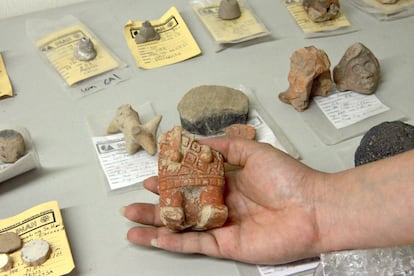Remains from Aztec New Fire ceremony discovered in Mexico City
Ahead of the ritual, which involved human sacrifice, the Mexica people would burn and throw away all of their belongings in the hope that a new life cycle would begin

The Mexica people in the Aztec Empire did not count time on an infinite scale, but rather in 52-year cycles. Under this calendar, every year lasted 260 days and every 52 years, a new cycle began. To herald in a new cycle, the Aztecs held a great rite known as the New Fire ceremony, which was the most important cyclical ritual of their culture.
Every 52 years, the inhabitants of Tenochtitlan, the capital of the Aztec Empire in what is now the historic center of Mexico City, threw away images of their gods and let the fires of their homes and temples go out. In the now darkened city, priests would walk from the Templo Mayor (or Main Temple) to a mountain called Huixachtlan (also known as Cerro de la Estrella), on the eastern bank of what was then Lake Texcoco. There, they performed a ceremony to light the new fire. The ritual triggered great uncertainty. If the new fire did not alight, the belief was that the world would end – the stars would turn into monsters and devour humankind. Five days before the ceremony, the people destroyed all their household belongings, fasting and crying as they waited for the catastrophe.
Now the remains of one of the last New Fire ceremonies have been discovered in the historical center of Mexico City by researchers at the History and Anthropology Institute (INAH). The investigators uncovered objects such as cajetas (a type of bowl), molcajetes (a stone tool similar to a mortar and pestle) and clay figurines in the midst of work to lay down drains, electric cables, and to erect new street benches.
“The pieces were found in San Fernando pantheon near San Hipólito church, in the old neighborhood of Cuepopan, which adjoins Tlatelolco, where Guerrero neighborhood is now located,” the archeologist Nancy Domínguez explains to EL PAÍS. “We were in a wetland area of a lake zone. The prehispanic rubbish was associated with the New Fire ceremony, in which people would get rid of important objects to symbolize a new cycle.”
During the ceremony, the inhabitants of Tenochtitlan would throw away the figures representing deities from their home altars; and destroy all their belongings – clothes, dishes and even the tenamaztli (a sacred stone stove). Everything was eight burnt or thrown into ditches, as was the case with this latest find.
According to the 1941 book Aztecs of Mexico by US anthropologist George Clapp Vaillant, the Mexica people interpreted the change in cycle as the end of life and the beginning of another. The scholar, who conducted seminal research on the Aztecs, wrote that pregnant women were locked up in farmhouses out of fear that they would turn into wild animals and children were made to walk and stay awake for fear that they would fall asleep on the fatal night and turn into rats. The house was also completely cleaned, with everything put in order, and the fires were put out, leaving complete darkness.

While darkness reigned in the homes of the Mexica people, the priests, dressed in ceremonial clothing, formed a procession to Huixachtlan.
Huixachtlan is the crater of an extinct volcano that rises sharply over the Valley of Mexico and is visible from nearly everywhere in Mexico City. Once at the top of the mountain, the priests would anxiously watch the sky for a sign that the world would continue. In the precise moment that the stars passed the meridian, the priests took a wooden tool and lit a fire in the open chest of a victim who had been sacrificed for this purpose. Priests, caciques (a type of prince) and the common people became delirious with happiness. Special runners lit torches with the fire and relit the fires at the altars in the temples of all the local people, explained George Clapp Vaillant in his book. “The fast torch bearers would run through the night like fireflies, bringing all men, women and children the promise of new life.”

“Generally, a pit was dug and in this pit, plates, bowls and glasses were thrown in,” explains Domínguez. “On many occasions, they used stones from the river to break the artifacts. They also used fire.” She adds that the Mexica people would also throw their belongings into the lake that used to exist in that area at the time. “This entire area was a lake, the streets we know today did not exist,” she explains.
At the excavation site, 17 bodies were also discovered, possibly the victims of disease outbreaks in the 19th century. The skeletons were found near San Fernando pantheon, which is one of the oldest in Mexico City and is also the resting place of notable Mexican figures such as former president Benito Juárez.

The project led by Domínguez is aimed at rescuing the archeological heritage of what is today the neighborhood of Guerrero. It has been proven that this area has been occupied since the last post-classic period (1250-1521), when it was a swampy zone on the outskirts of Tenochtitlan, through the colonial period, when it became home to convents and pastureland, up until the 19th century, when it turned into an illustrious neighborhood filled with large mansions. The work to protect this heritage will continue until the end of January 2022.
During the New Fire ceremony, if the world didn’t end and the stars did not turn into deadly monsters, the Mexica people would cheer up, clean up their homes, restore their temples and make new tools. As an extra sign of their appreciation, they would hold large feasts with special food and sacrifices – both of their own blood and that of their prisoners.
Tu suscripción se está usando en otro dispositivo
¿Quieres añadir otro usuario a tu suscripción?
Si continúas leyendo en este dispositivo, no se podrá leer en el otro.
FlechaTu suscripción se está usando en otro dispositivo y solo puedes acceder a EL PAÍS desde un dispositivo a la vez.
Si quieres compartir tu cuenta, cambia tu suscripción a la modalidad Premium, así podrás añadir otro usuario. Cada uno accederá con su propia cuenta de email, lo que os permitirá personalizar vuestra experiencia en EL PAÍS.
¿Tienes una suscripción de empresa? Accede aquí para contratar más cuentas.
En el caso de no saber quién está usando tu cuenta, te recomendamos cambiar tu contraseña aquí.
Si decides continuar compartiendo tu cuenta, este mensaje se mostrará en tu dispositivo y en el de la otra persona que está usando tu cuenta de forma indefinida, afectando a tu experiencia de lectura. Puedes consultar aquí los términos y condiciones de la suscripción digital.
More information
Archived In
Últimas noticias
Raúl Rocha, from jet-setting with Miss Universe to arms trafficking and fuel theft
80,000 barrels of Mexican oil sent to Cuba: Havana drawn into the US–Mexico clash
Human rights activists, opposition members, and a minor: Maduro’s other political prisoners
Israel sparks a civil war within the MAGA movement
Most viewed
- Reinhard Genzel, Nobel laureate in physics: ‘One-minute videos will never give you the truth’
- Pablo Escobar’s hippos: A serious environmental problem, 40 years on
- Charles Dubouloz, mountaineering star, retires at 36 with a farewell tour inspired by Walter Bonatti
- Why we lost the habit of sleeping in two segments and how that changed our sense of time
- The fall of a prolific science journal exposes the billion-dollar profits of scientific publishing











































